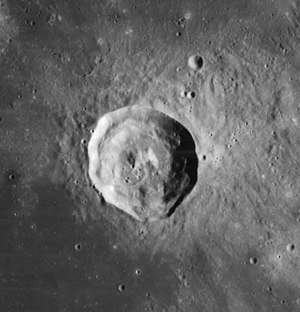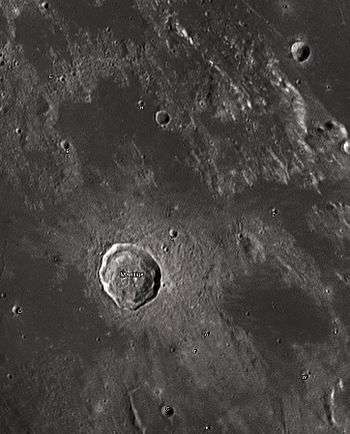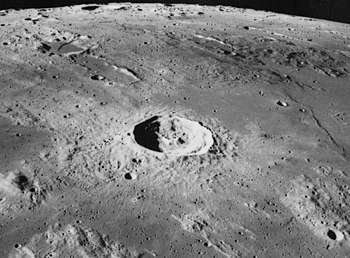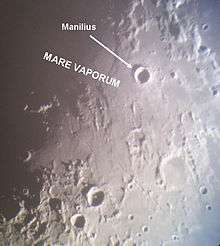Manilius (crater)
 Lunar Orbiter 4 image | |
| Coordinates | 14°30′N 9°06′E / 14.5°N 9.1°ECoordinates: 14°30′N 9°06′E / 14.5°N 9.1°E |
|---|---|
| Diameter | 39 km |
| Depth | 3.1 km |
| Colongitude | 351° at sunrise |
| Eponym | Marcus Manilius |
Manilius is a lunar impact crater on the northeast edge of Mare Vaporum. No prominent craters are located nearby but its nearest named prominent crater is Boscovich lying more than 100 km east-southeast, another is Julius Caesar which is more than 175 km southeast. The crater are surrounded by small mare plains ("lakes") including Laci Doloris, Gaudii and Lenitatis.
Its diameter is 39 km long and is 3,100 meters deep. The area is less than 1,100 km² and the perimeter is over 100 km.
Description
Manilius has a well-defined rim with a sloping inner surface that runs directly down to the ring-shaped mound of scree along the base, and a small outer rampart. The small crater interior has a higher albedo than the surroundings, and it appears bright when the sun is overhead. Within the crater is a central peak formation near the midpoint.
The crater also possesses a ray system that extends for a distance of over 300 kilometers. Despite the presence of these rays, which generally indicate the age of the crater as Copernican, the crater is currently mapped as Eratosthenian age.[1]
Names
Manilius is named after the Roman astronomer Marcus Manilius. Like many of the craters on the Moon's near side, it was given its name by Giovanni Riccioli, whose 1651 nomenclature system has become standardized.[2] Earlier lunar cartographers had given the feature different names. Michael van Langren's 1645 map calls it "Isabellae Reg. Hisp." (Isabella, Queen of Spain),[3] and Johannes Hevelius called it "Insula Besbicus" after the island in Turkey now known as İmralı.[4]
Satellite craters

By convention these features are identified on lunar maps by placing the letter on the side of the crater midpoint that is closest to Manilius.


| Manilius | Latitude | Longitude | Diameter |
|---|---|---|---|
| B | 16.6° N | 7.3° E | 6 km |
| C | 12.1° N | 10.4° E | 7 km |
| D | 13.2° N | 7.0° E | 5 km |
| E | 18.3° N | 6.4° E | 49 km |
| G | 15.5° N | 9.7° E | 5 km |
| H | 17.8° N | 8.6° E | 3 km |
| K | 11.9° N | 11.2° E | 3 km |
| T | 13.4° N | 10.6° E | 4 km |
| U | 13.8° N | 10.8° E | 4 km |
| W | 13.4° N | 12.9° E | 4 km |
| X | 14.4° N | 13.4° E | 3 km |
| Z | 16.4° N | 11.7° E | 3 km |
 Oblique view of Manilius G, northeast of Manilius
Oblique view of Manilius G, northeast of Manilius
The following craters have been renamed by the IAU.
References
- ↑ Stratigraphy of Lunar Craters, Don E. Wilhelms and Charles J. Byrne, January 23, 2009
- ↑ Ewen A. Whitaker, Mapping and Naming the Moon (Cambridge University Press, 1999), p.61.
- ↑ Ewen A. Whitaker, Mapping and Naming the Moon (Cambridge University Press, 1999), p. 198.
- ↑ Ewen A. Whitaker, Mapping and Naming the Moon (Cambridge University Press, 1999), p. 202.
- Andersson, L. E.; Whitaker, E. A. (1982). NASA Catalogue of Lunar Nomenclature. NASA RP-1097.
- Blue, Jennifer (July 25, 2007). "Gazetteer of Planetary Nomenclature". USGS. Retrieved 2007-08-05.
- Bussey, B.; Spudis, P. (2004). The Clementine Atlas of the Moon. New York: Cambridge University Press. ISBN 978-0-521-81528-4.
- Cocks, Elijah E.; Cocks, Josiah C. (1995). Who's Who on the Moon: A Biographical Dictionary of Lunar Nomenclature. Tudor Publishers. ISBN 978-0-936389-27-1.
- McDowell, Jonathan (July 15, 2007). "Lunar Nomenclature". Jonathan's Space Report. Retrieved 2007-10-24.
- Menzel, D. H.; Minnaert, M.; Levin, B.; Dollfus, A.; Bell, B. (1971). "Report on Lunar Nomenclature by the Working Group of Commission 17 of the IAU". Space Science Reviews. 12 (2): 136–186. Bibcode:1971SSRv...12..136M. doi:10.1007/BF00171763.
- Moore, Patrick (2001). On the Moon. Sterling Publishing Co. ISBN 978-0-304-35469-6.
- Price, Fred W. (1988). The Moon Observer's Handbook. Cambridge University Press. ISBN 978-0-521-33500-3.
- Rükl, Antonín (1990). Atlas of the Moon. Kalmbach Books. ISBN 978-0-913135-17-4.
- Webb, Rev. T. W. (1962). Celestial Objects for Common Telescopes (6th revised ed.). Dover. ISBN 978-0-486-20917-3.
- Whitaker, Ewen A. (1999). Mapping and Naming the Moon. Cambridge University Press. ISBN 978-0-521-62248-6.
- Wlasuk, Peter T. (2000). Observing the Moon. Springer. ISBN 978-1-85233-193-1.
Related articles
- Wood, Chuck (December 4, 2005). "A Line of Domes". Lunar Photo of the Day. Archived from the original on May 14, 2006. Retrieved 2006-07-21.
- Wood, Chuck (September 8, 2007). "Rare Image of a Common Crater". Lunar Photo of the Day. Archived from the original on June 30, 2015. Retrieved 2007-09-10.
External links
| Wikimedia Commons has media related to Manilius (crater). |